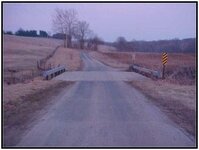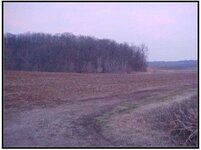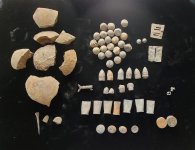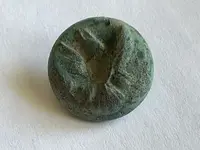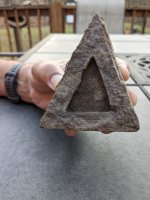Gypsy Heart
Gold Member
by John Winterbauer
In the lives of the early pioneers events sometimes occurred of such magnitude that they were used to mark time. The murder of Peggy Van Noy was just such an event. For years after residents would recall events (births, deaths i.e.), often starting with the phrase, "Two years before Van Noy was hung…" Nathaniel Van Noy and his wife, Peggy, came to the area that is now Menard County, Illinois. around 1820 settling a small tract of land that came to be known as Van Noy Settlement (about 5 miles west of Athens). The peaceful valley in which the Van Noys settled was comprised of primeval forest intersected by the road from Beardstown to Springfield, which was the main artery of traffic thru the area.
Nathaniel built a comfortable cabin on the south side of the road and a blacksmith shop on the north and began to ply his trade, catering to locals and travelers along the road. All seemed well enough with the Van Noys with the strange exception that Nathaniel was rarely home. The blacksmith would be gone for great lengths of time and upon his return would have plenty of money - this despite not firing his forge for weeks on end.
Apparently this curiosity didn't alarm his neighbors as they still came to Van Noy when they needed work done. On August 27, 1826 a local man and his young daughter made the trek to Van Noy Settlement to find the forge once again cold and the shop deserted. Curious, the father and daughter crossed the road to the Van Noy cabin to behold a horrific sight. There in a pool of blood lay Peggy Van Noy and her husband was nowhere to be found.
The man sent his daughter back thru the forest for help and local historian, John C. Harris wrote of the adventure years later, "a great aunt of mine, then a small girl, was among those sent out to summon the neighbors to the Van Noy cabin, and she used to tell of how fearful she was on that mission as she passed through the primeval forest lest a lurking Indian or Van Noy himself would jump out from behind a tree and kill her."
This photograph looks east down the Beardstown - Springfield Road. The Van Noy settlement was just across the bridge with the cabin on the right side of the road and the blacksmith shop on the left.
Several men arrived at the cabin to await the return of Nathaniel Van Noy. Hours passed and at some time during the vigil the men discovered the secret of Van Noy's mysterious wealth. Hidden on the homestead were the implements of counterfeiting. Later it would be revealed that Van Noy would make up a batch of phony cash and then travel to distant towns spending his bogus money and receiving real money back in change. But, certainly for the men waiting at the cabin, this discovery cast serious suspicion on Nathaniel's role in the death of his wife!
Late in the night Van Noy returned and was corralled by his captors. The blacksmith was visibly agitated and claimed to have been stalked all day by a deer he had wounded while hunting. Upon being questioned about Peggy's death he tried to shift blame to the Indians of a nearby village. This, apparently, was not satisfactory to his captors and Van Noy was turned over to Sheriff John Taylor.
Sheriff Taylor notified Judge John Sawyer who immediately called a special session of the Sangamon County Circuit Court. A grand jury was empanelled and sworn in to hear the case. The grand jury found sufficient evidence to try Van Noy for the murder and a jury was called to hear the case.
Bowling Green, future friend to Abraham Lincoln, was selected as foreman of the jury, which also consisted of Samuel Lee, Jesse Armstrong, Levi Gordon, Thomas Parish, Erastus Wright (who, coincidently, was the first school teacher in Sangamon County), William Vincent, Philip Fowler, John Stephenson, Levi Parish, James Collins and George Davenport.
The trial of Nathaniel Van Noy commenced on August 28, 1826 with Attorney General James Turney representing the people; James Adams and I.H. Pugh acted for the Defense. There is no record of the testimony for either side but it's not presumptuous to imagine the Defense was weak and evidence against Van Noy overwhelming because it only took a day for the jury to find him guilty of the gruesome crime. On August 28, 1826 Foreman Green read the verdict, "We the jury find the defendant guilty in manner and form as in the indictment against him is alleged" . At 9:00 the following morning Judge Sawyer issued the following ruling, "It is adjudged and considered by the Court that; the said defendant Nathaniel Van Noy, having been found guilty of the murder of his wife, Peggy Van Noy, by the jury impaneled and sworn in this cause, be remanded to the jail of the County and there kept until the twentieth day of November next and that on said twentieth day of November next between the hours of twelve of the clock and four of the clock in the afternoon that the Sheriff of said Sangamon County take the body of the said Nathaniel Van Noy to some convenient place in said County and that the said Sheriff cause the said Nathaniel Van Noy to be there hanged by the neck until he be dead."
In less than three days Van Noy's fate was sealed and he was removed to the County jail to await his execution.
Murder and counterfeiting would seem to be enough to make this story noteworthy however as Van Noy awaited his date with the gallows a series of strange events began to take place that would make any pulp fiction writer green with envy. It seems a Springfield doctor by the name of Addison Philleo had developed a device that if applied to a corpse just after death would reanimate the body. Dr. Philleo approached Van Noy in his cell and the two struck a bargain . Nathaniel Van Noy sold his corpse to Dr. Philleo; apparently with the belief he would be brought back from the dead shortly after his hanging.
On November 20, 1826, the day of Van Noy's hanging, a long procession formed at the county jail. Men, women and children proceeded through Springfield to a hollow north of the present state capital building to witness the spectacle. The wagon carrying Van Noy was driven beneath two posts, a noose slipped around his neck, the horses were started and Van Noy swung.
The body dangled for five hours before being cut down. Apparently Sheriff Taylor had heard of Dr. Philleo's deal with Van Noy and had decided not to turn over a fresh corpse. Dr. Philleo, thwarted in his experimentation, began an autopsy on the spot. This revolted onlookers so much the good doctor was forced to move to a nearby building to finish.
One of Van Noy's last public statements was that he had buried a quantity of gold beneath a tree in the valley near his cabin. For many years people searched for Van Noy's gold but to this day it has never been found.
By 1832 Dr. Philleo had relocated to Galena in northern Illinois where he published the Galenian, the only paper published north of Springfield. When the Black Hawk War broke out that Spring Dr. Philleo attached himself to the battalion of Maj. Henry Dodge as a war correspondent. As Dr. Philleo was the only newspaperman with the army his reports were published across the country.
Dr. Philleo's reports chronicled the campaign of Major Dodge. Philleo always referred to him as General Dodge, which gave readers the impression Dodge was in command when in reality General James D. Henry held that post. The reports were never officially corrected and the result was that for many years thereafter histories asserted Dodge and not Henry was in command.
A single martial deed can be attributed to Addison Philleo during the Black Hawk War. One day a scouting party came upon two of Black Hawk's warriors who attempted to flee. One of the Indians was killed in the chase. A short time later Dr. Philleo came across the body and scalped the Indian. For many years he displayed the scalp as evidence of his valor. Dr. Addison Philleo died in January 1841 in Tampa Bay, Florida.
As Van Noy's story passed into legend, the old homestead became a place to be feared by travelers on the road. Several pioneer memoirs recall hastening the horses as they passed by the former home of the Van Noys for fear of lurking ghosts. It is interesting to speculate on the thoughts of the young Lincoln as he often traveled the route during his time in New Salem, as it was the most direct route to Athens and Springfield beyond, he would have traveled that way often. The house was standing as late as the 1850's before mention of it stops in the accounts of the area settlers. Some say it was standing well into the twentieth century but there is no evidence to support this claim.
The Ghosts of Van Noy Settlement
Shortly after the hanging of the murdering Nathaniel, tales of the spirit of Peggy Van Noy wandering the fields around the house began to circulate. One story recalls a traveler who passed the house late one night only to be startled by the sounds of a woman's screams emitting from inside the dilapidated house. The man, unaware of the building's violent past, dismounted and entered the building to assist the obviously distraught woman.
After a few minutes of searching the premises and calling to whoever had screamed, the man was unable to locate the woman. Perplexed, he returned to his horse and continued his journey. When he reached the Hall tavern in Athens he told his story and was told the story of Peggy Van Noy's horrific murder.
Others reported the spectral form of a woman floating through the trees around the ramshackle cabin. While I can find no particularly interesting accounts, it is said that all the witnesses believed the ghost to be Peggy Van Noy. These reports continued for years and the old Menard families have preserved many as part of family lore. The existing tales are several generations old and, unfortunately, many specific details have been lost over time.
One story concerns the irate spirit of Nathaniel Van Noy and was told by my great-uncle, George Whitney, when I was about eight. George was a local historian of note in Athens. I didn't realize it then and had I known I would have paid more attention. This, perhaps more than any other story I've collected, illustrates how fact and legend
sometimes become blurred. The main protagonist of the tale, Alexander Hale, was a real man and resident of Athens he, in fact, was one of the town's early success stories. It is the inclusion of a real person that adds merit to a story such as the one my uncle told me all those years ago.
According to George's account Hale and two unnamed friends made the trek from Athens to the Van Noy farm under cover of darkness to search for the hidden gold. The men set to work but several hours passed with no trace of the treasure being found.
Late in the night the young men noticed an odd glow coming from deeper in the nearby woods. Believing it to be the lantern from a rival search party, they decided to sneak up on the other party and scare them away. As they quietly crept through the trees, one of the men entered a small clearing and came face-to-face with the source of the strange glow.
The approximate site of the Van Noy cabin. Peggy Van Noy’s ghost is said to wander the fields beyond and the wooded hill in the background is alleged to be the hiding place of Nathaniel’s missing gold.
He later recalled a man, surrounded by an unearthly glow, was staring at him and raised a threatening hand in his direction. The would-be treasure seeker didn't wait to see what the spectral man would say, he ran, screaming in terror, back toward Athens!
His companions, having not seen the ghost, and shocked by this bizarre turn, ran after their friend. After catching up with him further down the road and hearing his unlikely tale, Hale and the other wished to return but the scared third man would have nothing to do with the scheme. Eventually the others relented and accompanied their terrified partner home.
The next day Hale and the other man returned to the scene to collect their tools and look for signs of the mysterious "glowing man". Finding no sign of the ghost, they returned to Athens and there the story ends…or does it? The next year Hale, in partnership with John Overstreet, erected a large, brick flourmill in Athens at a cost of $11,000.00, no small sum in 1856. I'll put it to the reader as George put it to me…with a wink…isn't it fun to speculate where the money for the venture might have come from?
Today the valley seems quiet. One of the few remaining stretches of the old Beardstown road still passes the site of the old Van Noy homestead. Sometimes I drive through this peaceful valley and wonder if maybe Peggy still may wander these fields or if some unsuspecting soul may yet encounter the ghost of Nathaniel himself as he still protects his ill-begotten gold. Or maybe, just maybe, the ghosts are quiet now because a couple of entrepreneurs from Athens left old Van Noy with nothing to guard but an empty hole beneath a tree?
Sources:
Angle, Paul M., "Here I Have Lived" a History of Lincoln's Springfield, Rutgers University Press, New Brunswick, New Jersey, 1935
Eden, John R., personal interviews
Ford, Thomas, A History of Illinois from Its Commencement as a State in 1818 to 1847, S.S. Griggs, Chicago, Illinois, 1854
Harris, John C., unpublished manuscripts, Athens, Illinois, 1946-1948
Powers, John Carroll, History of Early Settlers in Sangamon County, Illinois, Edwin Wilson & Co.; Illinois, 1876
Court records, the People of Sangamon County, Illinois vs. Nathaniel Van Noy, September 28, 1826
Shannon, Helen Jensen, Athens, Illinois: a History, 1819-1986, Athens Public Library, Athens, Illinois, 1987
Tupker, Julie Bissell, genealogical information on Addison Philleo, email August, 2001
Whitney, George C., personal interviews
In the lives of the early pioneers events sometimes occurred of such magnitude that they were used to mark time. The murder of Peggy Van Noy was just such an event. For years after residents would recall events (births, deaths i.e.), often starting with the phrase, "Two years before Van Noy was hung…" Nathaniel Van Noy and his wife, Peggy, came to the area that is now Menard County, Illinois. around 1820 settling a small tract of land that came to be known as Van Noy Settlement (about 5 miles west of Athens). The peaceful valley in which the Van Noys settled was comprised of primeval forest intersected by the road from Beardstown to Springfield, which was the main artery of traffic thru the area.
Nathaniel built a comfortable cabin on the south side of the road and a blacksmith shop on the north and began to ply his trade, catering to locals and travelers along the road. All seemed well enough with the Van Noys with the strange exception that Nathaniel was rarely home. The blacksmith would be gone for great lengths of time and upon his return would have plenty of money - this despite not firing his forge for weeks on end.
Apparently this curiosity didn't alarm his neighbors as they still came to Van Noy when they needed work done. On August 27, 1826 a local man and his young daughter made the trek to Van Noy Settlement to find the forge once again cold and the shop deserted. Curious, the father and daughter crossed the road to the Van Noy cabin to behold a horrific sight. There in a pool of blood lay Peggy Van Noy and her husband was nowhere to be found.
The man sent his daughter back thru the forest for help and local historian, John C. Harris wrote of the adventure years later, "a great aunt of mine, then a small girl, was among those sent out to summon the neighbors to the Van Noy cabin, and she used to tell of how fearful she was on that mission as she passed through the primeval forest lest a lurking Indian or Van Noy himself would jump out from behind a tree and kill her."
This photograph looks east down the Beardstown - Springfield Road. The Van Noy settlement was just across the bridge with the cabin on the right side of the road and the blacksmith shop on the left.
Several men arrived at the cabin to await the return of Nathaniel Van Noy. Hours passed and at some time during the vigil the men discovered the secret of Van Noy's mysterious wealth. Hidden on the homestead were the implements of counterfeiting. Later it would be revealed that Van Noy would make up a batch of phony cash and then travel to distant towns spending his bogus money and receiving real money back in change. But, certainly for the men waiting at the cabin, this discovery cast serious suspicion on Nathaniel's role in the death of his wife!
Late in the night Van Noy returned and was corralled by his captors. The blacksmith was visibly agitated and claimed to have been stalked all day by a deer he had wounded while hunting. Upon being questioned about Peggy's death he tried to shift blame to the Indians of a nearby village. This, apparently, was not satisfactory to his captors and Van Noy was turned over to Sheriff John Taylor.
Sheriff Taylor notified Judge John Sawyer who immediately called a special session of the Sangamon County Circuit Court. A grand jury was empanelled and sworn in to hear the case. The grand jury found sufficient evidence to try Van Noy for the murder and a jury was called to hear the case.
Bowling Green, future friend to Abraham Lincoln, was selected as foreman of the jury, which also consisted of Samuel Lee, Jesse Armstrong, Levi Gordon, Thomas Parish, Erastus Wright (who, coincidently, was the first school teacher in Sangamon County), William Vincent, Philip Fowler, John Stephenson, Levi Parish, James Collins and George Davenport.
The trial of Nathaniel Van Noy commenced on August 28, 1826 with Attorney General James Turney representing the people; James Adams and I.H. Pugh acted for the Defense. There is no record of the testimony for either side but it's not presumptuous to imagine the Defense was weak and evidence against Van Noy overwhelming because it only took a day for the jury to find him guilty of the gruesome crime. On August 28, 1826 Foreman Green read the verdict, "We the jury find the defendant guilty in manner and form as in the indictment against him is alleged" . At 9:00 the following morning Judge Sawyer issued the following ruling, "It is adjudged and considered by the Court that; the said defendant Nathaniel Van Noy, having been found guilty of the murder of his wife, Peggy Van Noy, by the jury impaneled and sworn in this cause, be remanded to the jail of the County and there kept until the twentieth day of November next and that on said twentieth day of November next between the hours of twelve of the clock and four of the clock in the afternoon that the Sheriff of said Sangamon County take the body of the said Nathaniel Van Noy to some convenient place in said County and that the said Sheriff cause the said Nathaniel Van Noy to be there hanged by the neck until he be dead."
In less than three days Van Noy's fate was sealed and he was removed to the County jail to await his execution.
Murder and counterfeiting would seem to be enough to make this story noteworthy however as Van Noy awaited his date with the gallows a series of strange events began to take place that would make any pulp fiction writer green with envy. It seems a Springfield doctor by the name of Addison Philleo had developed a device that if applied to a corpse just after death would reanimate the body. Dr. Philleo approached Van Noy in his cell and the two struck a bargain . Nathaniel Van Noy sold his corpse to Dr. Philleo; apparently with the belief he would be brought back from the dead shortly after his hanging.
On November 20, 1826, the day of Van Noy's hanging, a long procession formed at the county jail. Men, women and children proceeded through Springfield to a hollow north of the present state capital building to witness the spectacle. The wagon carrying Van Noy was driven beneath two posts, a noose slipped around his neck, the horses were started and Van Noy swung.
The body dangled for five hours before being cut down. Apparently Sheriff Taylor had heard of Dr. Philleo's deal with Van Noy and had decided not to turn over a fresh corpse. Dr. Philleo, thwarted in his experimentation, began an autopsy on the spot. This revolted onlookers so much the good doctor was forced to move to a nearby building to finish.
One of Van Noy's last public statements was that he had buried a quantity of gold beneath a tree in the valley near his cabin. For many years people searched for Van Noy's gold but to this day it has never been found.
By 1832 Dr. Philleo had relocated to Galena in northern Illinois where he published the Galenian, the only paper published north of Springfield. When the Black Hawk War broke out that Spring Dr. Philleo attached himself to the battalion of Maj. Henry Dodge as a war correspondent. As Dr. Philleo was the only newspaperman with the army his reports were published across the country.
Dr. Philleo's reports chronicled the campaign of Major Dodge. Philleo always referred to him as General Dodge, which gave readers the impression Dodge was in command when in reality General James D. Henry held that post. The reports were never officially corrected and the result was that for many years thereafter histories asserted Dodge and not Henry was in command.
A single martial deed can be attributed to Addison Philleo during the Black Hawk War. One day a scouting party came upon two of Black Hawk's warriors who attempted to flee. One of the Indians was killed in the chase. A short time later Dr. Philleo came across the body and scalped the Indian. For many years he displayed the scalp as evidence of his valor. Dr. Addison Philleo died in January 1841 in Tampa Bay, Florida.
As Van Noy's story passed into legend, the old homestead became a place to be feared by travelers on the road. Several pioneer memoirs recall hastening the horses as they passed by the former home of the Van Noys for fear of lurking ghosts. It is interesting to speculate on the thoughts of the young Lincoln as he often traveled the route during his time in New Salem, as it was the most direct route to Athens and Springfield beyond, he would have traveled that way often. The house was standing as late as the 1850's before mention of it stops in the accounts of the area settlers. Some say it was standing well into the twentieth century but there is no evidence to support this claim.
The Ghosts of Van Noy Settlement
Shortly after the hanging of the murdering Nathaniel, tales of the spirit of Peggy Van Noy wandering the fields around the house began to circulate. One story recalls a traveler who passed the house late one night only to be startled by the sounds of a woman's screams emitting from inside the dilapidated house. The man, unaware of the building's violent past, dismounted and entered the building to assist the obviously distraught woman.
After a few minutes of searching the premises and calling to whoever had screamed, the man was unable to locate the woman. Perplexed, he returned to his horse and continued his journey. When he reached the Hall tavern in Athens he told his story and was told the story of Peggy Van Noy's horrific murder.
Others reported the spectral form of a woman floating through the trees around the ramshackle cabin. While I can find no particularly interesting accounts, it is said that all the witnesses believed the ghost to be Peggy Van Noy. These reports continued for years and the old Menard families have preserved many as part of family lore. The existing tales are several generations old and, unfortunately, many specific details have been lost over time.
One story concerns the irate spirit of Nathaniel Van Noy and was told by my great-uncle, George Whitney, when I was about eight. George was a local historian of note in Athens. I didn't realize it then and had I known I would have paid more attention. This, perhaps more than any other story I've collected, illustrates how fact and legend
sometimes become blurred. The main protagonist of the tale, Alexander Hale, was a real man and resident of Athens he, in fact, was one of the town's early success stories. It is the inclusion of a real person that adds merit to a story such as the one my uncle told me all those years ago.
According to George's account Hale and two unnamed friends made the trek from Athens to the Van Noy farm under cover of darkness to search for the hidden gold. The men set to work but several hours passed with no trace of the treasure being found.
Late in the night the young men noticed an odd glow coming from deeper in the nearby woods. Believing it to be the lantern from a rival search party, they decided to sneak up on the other party and scare them away. As they quietly crept through the trees, one of the men entered a small clearing and came face-to-face with the source of the strange glow.
The approximate site of the Van Noy cabin. Peggy Van Noy’s ghost is said to wander the fields beyond and the wooded hill in the background is alleged to be the hiding place of Nathaniel’s missing gold.
He later recalled a man, surrounded by an unearthly glow, was staring at him and raised a threatening hand in his direction. The would-be treasure seeker didn't wait to see what the spectral man would say, he ran, screaming in terror, back toward Athens!
His companions, having not seen the ghost, and shocked by this bizarre turn, ran after their friend. After catching up with him further down the road and hearing his unlikely tale, Hale and the other wished to return but the scared third man would have nothing to do with the scheme. Eventually the others relented and accompanied their terrified partner home.
The next day Hale and the other man returned to the scene to collect their tools and look for signs of the mysterious "glowing man". Finding no sign of the ghost, they returned to Athens and there the story ends…or does it? The next year Hale, in partnership with John Overstreet, erected a large, brick flourmill in Athens at a cost of $11,000.00, no small sum in 1856. I'll put it to the reader as George put it to me…with a wink…isn't it fun to speculate where the money for the venture might have come from?
Today the valley seems quiet. One of the few remaining stretches of the old Beardstown road still passes the site of the old Van Noy homestead. Sometimes I drive through this peaceful valley and wonder if maybe Peggy still may wander these fields or if some unsuspecting soul may yet encounter the ghost of Nathaniel himself as he still protects his ill-begotten gold. Or maybe, just maybe, the ghosts are quiet now because a couple of entrepreneurs from Athens left old Van Noy with nothing to guard but an empty hole beneath a tree?
Sources:
Angle, Paul M., "Here I Have Lived" a History of Lincoln's Springfield, Rutgers University Press, New Brunswick, New Jersey, 1935
Eden, John R., personal interviews
Ford, Thomas, A History of Illinois from Its Commencement as a State in 1818 to 1847, S.S. Griggs, Chicago, Illinois, 1854
Harris, John C., unpublished manuscripts, Athens, Illinois, 1946-1948
Powers, John Carroll, History of Early Settlers in Sangamon County, Illinois, Edwin Wilson & Co.; Illinois, 1876
Court records, the People of Sangamon County, Illinois vs. Nathaniel Van Noy, September 28, 1826
Shannon, Helen Jensen, Athens, Illinois: a History, 1819-1986, Athens Public Library, Athens, Illinois, 1987
Tupker, Julie Bissell, genealogical information on Addison Philleo, email August, 2001
Whitney, George C., personal interviews


